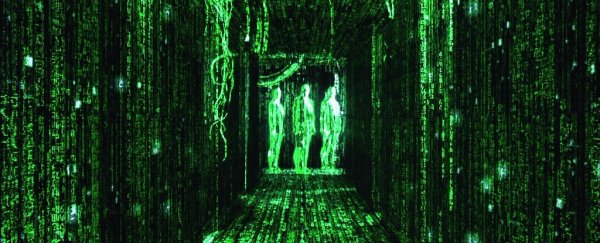Questions of whether our reality is a simulation of something deeper have kept philosophers and freshmen awake since Plato was a pup.
A pair of physicists sleep a lot easier at night now that they've shown that quantum weirdness involving twists in space-time can't conceivably be simulated, adding to a list of problems that The Matrix would have no answer for. Sorry Neo.
Theoretical physicists Zohar Ringel and Dmitry Kovrizhin from the University of Oxford and the Hebrew University in Israel found a solid road-block to solving algorithms involving quantum-based Monte Carlo simulations.
The short version is, it basically means we can't model the physics we know of on even the biggest computer imaginable.
You're not in a simulation. Probably not, at least.
Still with us? Ok, come on down.
Monte Carlo simulations are computations based on random samples of a system. They're not particular to quantum physics, but they are useful for turning the fuzzy world of maybes into something a bit more predictable.
For the most part they can help make short work of certain many-body problems – systems involving multiple quantum objects moving about through various dimensions.
Quantum Monte Carlo simulations are by no means perfect, though. A certain cancelling out of positives and negatives can arise, something referred to as a sign problem.
Sign-free representation would help get around it, but the way to do this for a lot of physics problems remains unclear. In fact, for some it might be downright impossible.
That's the question Ringel and Kovrizhin were tackling; is there some sort of barrier to finding a sign-free way of applying Monte Carlo simulations to certain quantum systems?
If there isn't, then maybe – just maybe – you're lying bathed in gel in a pod somewhere with tubes in your head while a giant computer milks you for electricity in the world's most inefficient battery.
But should there be an obstacle, it means classical computers could never solve the underlying mathematics to represent what we're observing in quantum mechanics. Rest assured, that steak is 100 percent bovine muscle and not just binary code.
In condensed matter physics there's a phenomenon called the thermal Hall effect, where placing a solid object with a hot end and a cold end inside a magnetic field produces a thermal gradient across it as well.
If you're a high energy physicist, you might describe the same thing as a gravitational anomaly, which in simplistic terms is a bit like thinking of the fabric of space-time as biased or warped.
The theorists crunched the numbers on models involving Monte Carlo simulations solving gravitational anomalies, demonstrating no matter which way you cut it, that sign problem is there to stay.
"Our work provides an intriguing link between two seemingly unrelated topics: gravitational anomalies and computational complexity," says Ringel.
"It also shows that the thermal Hall conductance is a genuine quantum effect: one for which no local classical analogue exists."
Hollywood aside, questions on whether a Universe – either this one, or one constructed at our own hand – can be simulated through some sort of computer are taken seriously in some philosophical circles.
British philosopher Nick Bostrom has argued it's likely, based on several premises on time and technological advances.
Physicists have pointed out that quantum physics makes this incredibly unlikely, given electrons and atoms aren't tiny balls whizzing predictably through space.
Ringel and Kovrizhin have given us just one more reason to suspect that if we're all operating on a supra-dimensional alien version of Windows 11, it's not a computer system we can easily imagine.
Looks like we're stuck with this reality. Might as well start making the best of it.
This research was published in Science Advances.
